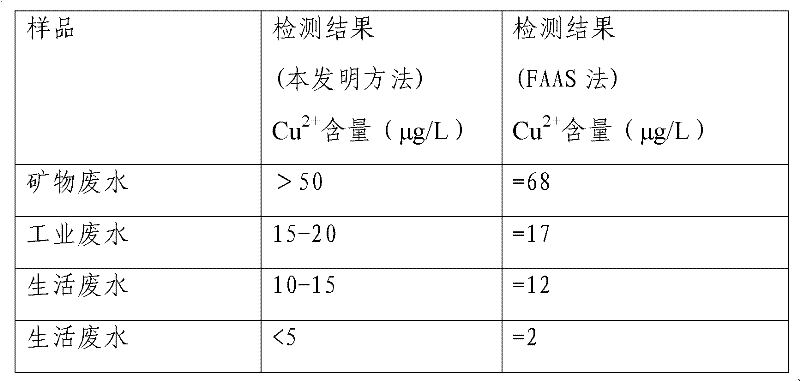Method for detecting trace copper in wastewater rapidly
A waste water, rapid technology, applied in the field of analytical chemistry, can solve the problems of expensive instruments and consumables, difficulty in general application, low detection limit, etc., and achieve the effect of easy observation, simple operation method and wide detection range
- Summary
- Abstract
- Description
- Claims
- Application Information
AI Technical Summary
Problems solved by technology
Method used
Image
Examples
Embodiment 1
[0023] ① Mix 5mL of mineral waste water with Cu 2+ Put 5 mL each of the standard series of solutions in centrifuge tubes with stoppers, add 1 mL of DDTC-Na solution with a concentration of 30 μg / mL to each centrifuge tube, and adjust the pH to 5 with acetic acid-sodium acetate buffer solution; Mix carbon chloride and 0.5mL acetone; ③Use a syringe to absorb the mixed solution in step ②, quickly pour it into the centrifuge tube in step ①, and ultrasonicate at 35kHz for 10min to form a uniform emulsified system; ④put the centrifuge tube in step ③ at 6000 Centrifuge under the condition of 5min / min, break the emulsion, the extractant forms a drop at the bottom of the centrifuge tube, and the DDTC-Cu complex is extracted into this drop of extractant; ⑤ Under the same conditions, the mineral waste water forms a yellow drop at the bottom of the centrifuge tube Comparing the color scale of a drop of solution formed by the solution and the standard series of solutions, the color of a dr...
Embodiment 2
[0025] ① Mix 5mL of industrial wastewater with Cu 2+ Put 5 mL each of the standard series of solutions in centrifuge tubes with stoppers, add 1 mL of DDTC-Na solution with a concentration of 20 μg / mL to each centrifuge tube, and adjust the pH to 5 with acetic acid-sodium acetate buffer solution; ② Add 100 μL of chloroform Mix with 0.5mL acetonitrile; ③Use a syringe to absorb the mixed solution in step ②, quickly pour it into the centrifuge tube in step ①, and ultrasonicate at 50kHz for 4min to form a uniform emulsion system; ④Put the centrifuge tube in step ③ at 4000r / min Centrifuge for 7 minutes to break the emulsion, and the extractant forms a drop at the bottom of the centrifuge tube, and the DDTC-Cu complex is extracted into this drop of extractant; ⑤Under the same conditions, the industrial wastewater forms a drop of yellow solution and standard The color scale comparison of a drop of solution formed by a series of solutions shows that the color of a drop of waste water i...
Embodiment 3
[0027] ① Mix 5mL domestic wastewater with Cu 2+ Put 5 mL each of the standard series of solutions into centrifuge tubes with stoppers, add 1 mL of DDTC-Na solution with a concentration of 25 μg / mL to each centrifuge tube, and adjust the pH to 5 with acetic acid-sodium acetate buffer solution; ② Add 100 μL of two Mix the methyl chloride and 0.5mL Triton X-100; ③ Draw the mixed solution in step ② with a syringe, quickly pour it into the centrifuge tube in step ①, and ultrasonicate at 40kHz for 6min to form a uniform emulsified system; ④ put the centrifuge tube in step ③ Centrifuge at 8000r / min for 5 minutes to break the emulsion, and the extractant forms a drop at the bottom of the centrifuge tube, and the DDTC-Cu complex is extracted into this drop of extractant; Comparing the color scale of a drop of yellow solution and a drop of standard series solution, the color of a drop of waste water is between the color of 10-15μg / L standard copper solution, and the color of industrial ...
PUM
 Login to View More
Login to View More Abstract
Description
Claims
Application Information
 Login to View More
Login to View More - R&D
- Intellectual Property
- Life Sciences
- Materials
- Tech Scout
- Unparalleled Data Quality
- Higher Quality Content
- 60% Fewer Hallucinations
Browse by: Latest US Patents, China's latest patents, Technical Efficacy Thesaurus, Application Domain, Technology Topic, Popular Technical Reports.
© 2025 PatSnap. All rights reserved.Legal|Privacy policy|Modern Slavery Act Transparency Statement|Sitemap|About US| Contact US: help@patsnap.com

